Plant Science Research Weekly: May 15th
Review: Evo-physio: on stress responses and the earliest land plants
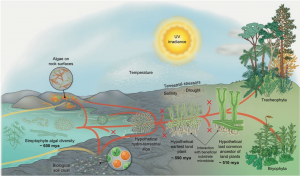 Streptophytes are a grade of mostly freshwater algae that transitioned into land, a singularity that in turn gave rise to all present terrestrial flora. This passage along the hydrological gradient that culminated in land habitation required key adaptations to overcome previously unencountered terrestrial stressors such as UV radiation, and hydric and temperature stress. In this review, Fürst-Jansen et al. highlight probable core traits and networks that allowed the early land plants to thrive and survive. The authors note that many streptophyte algae possess traits and signaling networks previously thought to be land plant-specific (e.g., rhizoids, hormonal response to biotic and abiotic cues, auxin signaling) and call attention to the fact that many of the genes required for these processes were present in early land plants, even if they didn’t act in precisely the same process. The fact that streptophytes were ready to overcome challenges is supported by the fact that most (>80%) of the land plant repertoire of transcriptional regulators is present in streptophytes, with many of their stress response and developmental regulators probably being co-opted to perform other functions in other land plant lineages due to the moldability of their genetic frameworks. This study summarizes core signaling networks to infer the “terrestrialization toolkit” that made the singularity of plant colonization possible. (Summary by Jesus Leon @jesussaur). J. Exp. Bot. 10.1093/jxb/eraa007
Streptophytes are a grade of mostly freshwater algae that transitioned into land, a singularity that in turn gave rise to all present terrestrial flora. This passage along the hydrological gradient that culminated in land habitation required key adaptations to overcome previously unencountered terrestrial stressors such as UV radiation, and hydric and temperature stress. In this review, Fürst-Jansen et al. highlight probable core traits and networks that allowed the early land plants to thrive and survive. The authors note that many streptophyte algae possess traits and signaling networks previously thought to be land plant-specific (e.g., rhizoids, hormonal response to biotic and abiotic cues, auxin signaling) and call attention to the fact that many of the genes required for these processes were present in early land plants, even if they didn’t act in precisely the same process. The fact that streptophytes were ready to overcome challenges is supported by the fact that most (>80%) of the land plant repertoire of transcriptional regulators is present in streptophytes, with many of their stress response and developmental regulators probably being co-opted to perform other functions in other land plant lineages due to the moldability of their genetic frameworks. This study summarizes core signaling networks to infer the “terrestrialization toolkit” that made the singularity of plant colonization possible. (Summary by Jesus Leon @jesussaur). J. Exp. Bot. 10.1093/jxb/eraa007
“Order by disorder”- intrinsically disordered proteins
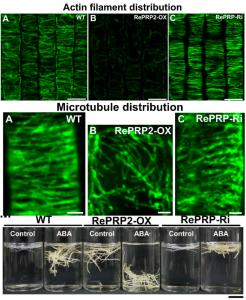 Intrinsically disordered proteins (IDP) have repetitive protein sequences but lack a defined 3D structure and are deployed to do some challenging functions that a protein with a defined 3D structure cannot perform. One such IDP, Oryza sativa REPETITIVE PROLINE-RICH PROTEIN (OsRePRP) is involved in inhibiting root growth during stress conditions. In this paper, Hsiao et al. showed the mechanism through which OsRePRP regulates root growth in response to stress. OsRePRPs are rich in proline residues (40%) and interact with cytoskeletal elements (actin and microtubules) in vitro and in vivo. Through these interactions, OsRePRP alters the abundance of filamentous actin and changes the orientation of microtubules, decreasing the molecular traffic of materials that are required for cell wall synthesis and leading to decreased cell elongation. In addition to affecting the cytoskeleton, OsRePRP promotes the activity of sucrose synthase, which converts sucrose to NDP-glucose, a precursor for starch synthesis, leading to the storage of starch in the roots. Thus, the intrinsically disordered protein OsRePRP brings “order by disorder” by adapting plants to cope up with stress conditions. (Summary by Vijaya Batthula @Vijaya_Batthula). Plant Physiol. 10.1104/pp.19.01372
Intrinsically disordered proteins (IDP) have repetitive protein sequences but lack a defined 3D structure and are deployed to do some challenging functions that a protein with a defined 3D structure cannot perform. One such IDP, Oryza sativa REPETITIVE PROLINE-RICH PROTEIN (OsRePRP) is involved in inhibiting root growth during stress conditions. In this paper, Hsiao et al. showed the mechanism through which OsRePRP regulates root growth in response to stress. OsRePRPs are rich in proline residues (40%) and interact with cytoskeletal elements (actin and microtubules) in vitro and in vivo. Through these interactions, OsRePRP alters the abundance of filamentous actin and changes the orientation of microtubules, decreasing the molecular traffic of materials that are required for cell wall synthesis and leading to decreased cell elongation. In addition to affecting the cytoskeleton, OsRePRP promotes the activity of sucrose synthase, which converts sucrose to NDP-glucose, a precursor for starch synthesis, leading to the storage of starch in the roots. Thus, the intrinsically disordered protein OsRePRP brings “order by disorder” by adapting plants to cope up with stress conditions. (Summary by Vijaya Batthula @Vijaya_Batthula). Plant Physiol. 10.1104/pp.19.01372
MYB30 negatively regulates photomorphogenesis by interacting with PIFs and phytochromes in Arabidopsis
 Photomorphogenesis is the growth and development of plants in response to light. The phytochrome family of photoreceptors absorbs red and far-red light, and in Arabidopsis the most abundant phytochromes are phyA and phyB. PHYTOCHROME-INTERACTING FACTORS (PIFs) repress photomorphogenesis, and under red light, phytochromes mediate PIF degradation. Here, Yan et al. reveal MYB30 as a negative regulator of photomorphogenesis. Under darkness, PIF4 and PIF5 encourage hypocotyl elongation by instigating the expression of growth-promoting genes, while MYB30 protein levels are kept low due to proteasome-mediated degradation. During short exposure to red light, active phyA and phyB facilitate PIF4 and PIF5 proteasome-mediated degradation and induce MYB30 abundance. Under longer exposure to red light, MYB30 directly binds to PIF4 and PIF5 promoters, inducing their reaccumulation while simultaneously inhibiting PIF-phytochrome interactions. Finally, MYB30 interacts with PIFs to collectively repress photomorphogenesis by inducing the expression of growth-promoting genes. In summary, MYB30 is an essential regulator of PIF-phytochrome signaling and facilitates the efficient and accurate response of plants to dynamic light conditions. (Summary by Caroline Dowling @CarolineD0wling) Plant Cell 10.1105/tpc.19.00645
Photomorphogenesis is the growth and development of plants in response to light. The phytochrome family of photoreceptors absorbs red and far-red light, and in Arabidopsis the most abundant phytochromes are phyA and phyB. PHYTOCHROME-INTERACTING FACTORS (PIFs) repress photomorphogenesis, and under red light, phytochromes mediate PIF degradation. Here, Yan et al. reveal MYB30 as a negative regulator of photomorphogenesis. Under darkness, PIF4 and PIF5 encourage hypocotyl elongation by instigating the expression of growth-promoting genes, while MYB30 protein levels are kept low due to proteasome-mediated degradation. During short exposure to red light, active phyA and phyB facilitate PIF4 and PIF5 proteasome-mediated degradation and induce MYB30 abundance. Under longer exposure to red light, MYB30 directly binds to PIF4 and PIF5 promoters, inducing their reaccumulation while simultaneously inhibiting PIF-phytochrome interactions. Finally, MYB30 interacts with PIFs to collectively repress photomorphogenesis by inducing the expression of growth-promoting genes. In summary, MYB30 is an essential regulator of PIF-phytochrome signaling and facilitates the efficient and accurate response of plants to dynamic light conditions. (Summary by Caroline Dowling @CarolineD0wling) Plant Cell 10.1105/tpc.19.00645
Endosidin20 targets the cellulose synthase catalytic domain to inhibit cellulose biosynthesis
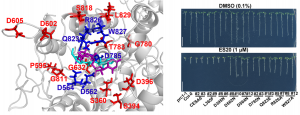 Cellulose is an indispensable component of plant cell wall formation. Cellulose is synthesized at the plasma membrane by a cellulose synthase complex (CSC) made up of at least 18 monomeric cellulose synthases (CESAs). In this study, Huang et al. used a chemical genetic approach to explore the structure and function of the cellulose synthase complex. Endosidin20 (ES20)-treated seedlings have shorter, swollen roots, with reduced cell length and increased width reminiscent of roots of CESA mutants and plants treated with cellulose synthsis inhibitors. Chemical-genetic screening from EMS mutagenized population for ES20 resistant lines identified 15 alleles with missense mutations in CESA6. These mutated amino acids are in the conserved regions of all Arabidopsis CESAs and reside in the catalytic cytoplasmic domain, where both ES20 and UDP-glucose phosphonate are docked based on structural model and molecular docking. Furthermore, ES20 impairs CSC (cellulose synthase complex) trafficking dynamics, based on Fluorescence Recovery After Photobleaching (FRAP) assay. The link between catalytic activity and trafficking remains to be explored, but this study has generated a new inhibitor and mutants that will be useful research tools. (Summary by Arif Ashraf) Plant Cell 10.1105/tpc.20.00202
Cellulose is an indispensable component of plant cell wall formation. Cellulose is synthesized at the plasma membrane by a cellulose synthase complex (CSC) made up of at least 18 monomeric cellulose synthases (CESAs). In this study, Huang et al. used a chemical genetic approach to explore the structure and function of the cellulose synthase complex. Endosidin20 (ES20)-treated seedlings have shorter, swollen roots, with reduced cell length and increased width reminiscent of roots of CESA mutants and plants treated with cellulose synthsis inhibitors. Chemical-genetic screening from EMS mutagenized population for ES20 resistant lines identified 15 alleles with missense mutations in CESA6. These mutated amino acids are in the conserved regions of all Arabidopsis CESAs and reside in the catalytic cytoplasmic domain, where both ES20 and UDP-glucose phosphonate are docked based on structural model and molecular docking. Furthermore, ES20 impairs CSC (cellulose synthase complex) trafficking dynamics, based on Fluorescence Recovery After Photobleaching (FRAP) assay. The link between catalytic activity and trafficking remains to be explored, but this study has generated a new inhibitor and mutants that will be useful research tools. (Summary by Arif Ashraf) Plant Cell 10.1105/tpc.20.00202
Mutations PETALOSA cause a dominant double-flower phenotype in phylogenetically distant eudicots
 Flower development has always been a fascinating field of research in plant biology. While molecular studies in the past focused on regulatory genes involved in the formation of floral organs in model species, current investigations are addressing the genetic determinants underlying the huge variety of flower. Recently, the genetic basis of the double flower trait was deciphered in ornamental plants belonging to the Rosaceae family. This phenotype is caused by mutations in the 3’ end of regulatory genes belonging to the TARGET OF EAT subfamily, which result in truncated transcripts lacking the miR172 target site crucial for post-transcriptional regulation. In this new article, Gattolin and coworkers analyzed the same mutations in orthologous genes which they named PETALOSA (PET) in important ornamental plants – including carnation, Petunia hybrida and Rosa rugosa. (Note – see the interesting story of the origin of this gene name, in Italian and in English). The pet mutant alleles co-segregated with the double flower phenotype in all commercial varieties examined. Considering that the single flower phenotype is the ancestral state for the ornamental plants studied, these findings suggest a convergent human selection of the double flower trait aimed at improving their attractiveness in phylogenetically distant eudicots. Finally, the authors provided evidence that genome editing could be successfully applied in economically important plants to modify flower shape. Indeed, a 1 bp insertion in tobacco PET genes obtained by CRISP-Cas9 technology correlates with the formation of supernumerary petals in transgenic plants. (Summary by Michela Osnato @michela_osnato) J. Exp. Bot. 10.1093/jxb/eraa032
Flower development has always been a fascinating field of research in plant biology. While molecular studies in the past focused on regulatory genes involved in the formation of floral organs in model species, current investigations are addressing the genetic determinants underlying the huge variety of flower. Recently, the genetic basis of the double flower trait was deciphered in ornamental plants belonging to the Rosaceae family. This phenotype is caused by mutations in the 3’ end of regulatory genes belonging to the TARGET OF EAT subfamily, which result in truncated transcripts lacking the miR172 target site crucial for post-transcriptional regulation. In this new article, Gattolin and coworkers analyzed the same mutations in orthologous genes which they named PETALOSA (PET) in important ornamental plants – including carnation, Petunia hybrida and Rosa rugosa. (Note – see the interesting story of the origin of this gene name, in Italian and in English). The pet mutant alleles co-segregated with the double flower phenotype in all commercial varieties examined. Considering that the single flower phenotype is the ancestral state for the ornamental plants studied, these findings suggest a convergent human selection of the double flower trait aimed at improving their attractiveness in phylogenetically distant eudicots. Finally, the authors provided evidence that genome editing could be successfully applied in economically important plants to modify flower shape. Indeed, a 1 bp insertion in tobacco PET genes obtained by CRISP-Cas9 technology correlates with the formation of supernumerary petals in transgenic plants. (Summary by Michela Osnato @michela_osnato) J. Exp. Bot. 10.1093/jxb/eraa032
Hydrogen mediates tolerance to cadmium-induced root toxicity
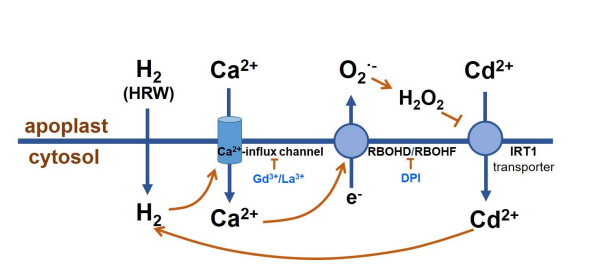 Heavy metals are a potential threat to human health, especially in areas with high industrial activity where the metals leach in the soil to contaminate underground water. These metals are a threat to plants too, resulting in stunted growth and their eventual death. Wu et al. carried out a mechanistic analysis of how plants use multiple signaling components to enhance tolerance to cadmium (Cd)-induced toxicity in roots. Application of Cd results in production of hydrogen (H2) gas in roots, which by hitherto unidentified protein(s), enable(s) inflow of calcium (Ca2+) ions. The Ca2+ then induces cytosolic influx of hydrogen peroxide (H2O2) through NADPH oxidases, resulting in the down-regulation of the gene encoding IRT1 transceptor, which acts as a conduit for Cd2+ influx. This study is significant since it establishes the likely role of H2 gas as a signaling agent in plants. (Summary by Pavithran Narayanan @pavi_narayanan). Plant Physiol. 10.1104/pp.20.00377
Heavy metals are a potential threat to human health, especially in areas with high industrial activity where the metals leach in the soil to contaminate underground water. These metals are a threat to plants too, resulting in stunted growth and their eventual death. Wu et al. carried out a mechanistic analysis of how plants use multiple signaling components to enhance tolerance to cadmium (Cd)-induced toxicity in roots. Application of Cd results in production of hydrogen (H2) gas in roots, which by hitherto unidentified protein(s), enable(s) inflow of calcium (Ca2+) ions. The Ca2+ then induces cytosolic influx of hydrogen peroxide (H2O2) through NADPH oxidases, resulting in the down-regulation of the gene encoding IRT1 transceptor, which acts as a conduit for Cd2+ influx. This study is significant since it establishes the likely role of H2 gas as a signaling agent in plants. (Summary by Pavithran Narayanan @pavi_narayanan). Plant Physiol. 10.1104/pp.20.00377
A moonlighting kinase induces immune responses in rice and Arabidopsis ($)
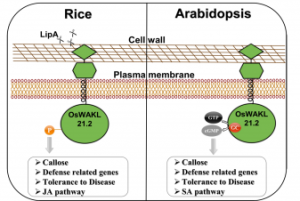 Bacterial infections are a serious issue for crop plants and it is thus imperative to understand the mechanisms employed by plants to develop resistance against pathogens. Malukani et al. have identified a receptor kinase in rice, WALL-ASSOCIATED KINASE-LIKE 21 (OsWAKL21.2) that perceives pathogen-induced damage to the plant cell wall. Overexpression of this kinase in rice brings about immune responses, including up-regulation of key genes involved in resistance against bacterial pathogens. The authors find it to be a moonlighting kinase that possesses guanylate cyclase (GS) activity too (the term moonlighting is an expression used for something that has two jobs). Quite interestingly, the activity of this enzyme seems to be species-specific – while kinase activity is essential for immune responses in rice, it displays GS activity when expressed in Arabidopsis thaliana to trigger immune responses. Further analyses seem to suggest that this enzyme could target two different pathways in the two species – jasmonic acid (JA)-mediated pathways in rice and salicylic acid (SA)-mediated pathways in Arabidopsis. (Summary by Pavithran Narayanan @pavi_narayanan) Plant Physiol. 10.1104/pp.19.01579
Bacterial infections are a serious issue for crop plants and it is thus imperative to understand the mechanisms employed by plants to develop resistance against pathogens. Malukani et al. have identified a receptor kinase in rice, WALL-ASSOCIATED KINASE-LIKE 21 (OsWAKL21.2) that perceives pathogen-induced damage to the plant cell wall. Overexpression of this kinase in rice brings about immune responses, including up-regulation of key genes involved in resistance against bacterial pathogens. The authors find it to be a moonlighting kinase that possesses guanylate cyclase (GS) activity too (the term moonlighting is an expression used for something that has two jobs). Quite interestingly, the activity of this enzyme seems to be species-specific – while kinase activity is essential for immune responses in rice, it displays GS activity when expressed in Arabidopsis thaliana to trigger immune responses. Further analyses seem to suggest that this enzyme could target two different pathways in the two species – jasmonic acid (JA)-mediated pathways in rice and salicylic acid (SA)-mediated pathways in Arabidopsis. (Summary by Pavithran Narayanan @pavi_narayanan) Plant Physiol. 10.1104/pp.19.01579
Mechanistic insights into host perception by a fungal pathogen
 Host perception is crucial for soil-borne microbes to successfully colonize plant roots. Ding et al. conducted transcriptome analysis of the fungal pathogen Fusarium graminearum (Fg) in the presence of its host plant Brachypodium distachyon (Bd), either without direct contact (precontact) or during colonization. Fg showed distinct transcriptome patterns between the precontact and colonization stages. The authors showed that precontact transcriptional reprogramming in Fg is triggered by plant-derived small molecules induced upon fungal recognition. Fg produces nitric oxide (NO) during the precontact stage and exogenous treatment with NO mimicked the precontact fungal gene expression. Reverse genetics screening of differentially regulated fungal genes identified 15 out of 19 mutants showing reduced virulence in the host plant. Among these genes was FgANK1, an ankyrin-repeat domain-containing protein. The fgank1 mutant lacked host-induced NO production and marker gene expression. Yeast-two hybrid screening identified that FgANK1 interacts with the transcription factor FgZC1. In vivo interaction between FgANK1 and FgZC1 requires precontact with Bd, and the fgzc1 mutant was, like the fgank1 mutant, abolished in NO production and impaired in virulence. Together, the authors proposed a model where sensing of host-derived signals induces FgANK1, which, together with FgZC1, promotes NO production in the fungus to control various processes, including virulence-associated functions. This study provides insights into a two-way molecular dialogue between plants and a fungal pathogen in the rhizosphere. (Summary by Tatsuya Nobori @nobolly) Proc. Natl. Acad. Sci. USA 10.1073/pnas.1918977117
Host perception is crucial for soil-borne microbes to successfully colonize plant roots. Ding et al. conducted transcriptome analysis of the fungal pathogen Fusarium graminearum (Fg) in the presence of its host plant Brachypodium distachyon (Bd), either without direct contact (precontact) or during colonization. Fg showed distinct transcriptome patterns between the precontact and colonization stages. The authors showed that precontact transcriptional reprogramming in Fg is triggered by plant-derived small molecules induced upon fungal recognition. Fg produces nitric oxide (NO) during the precontact stage and exogenous treatment with NO mimicked the precontact fungal gene expression. Reverse genetics screening of differentially regulated fungal genes identified 15 out of 19 mutants showing reduced virulence in the host plant. Among these genes was FgANK1, an ankyrin-repeat domain-containing protein. The fgank1 mutant lacked host-induced NO production and marker gene expression. Yeast-two hybrid screening identified that FgANK1 interacts with the transcription factor FgZC1. In vivo interaction between FgANK1 and FgZC1 requires precontact with Bd, and the fgzc1 mutant was, like the fgank1 mutant, abolished in NO production and impaired in virulence. Together, the authors proposed a model where sensing of host-derived signals induces FgANK1, which, together with FgZC1, promotes NO production in the fungus to control various processes, including virulence-associated functions. This study provides insights into a two-way molecular dialogue between plants and a fungal pathogen in the rhizosphere. (Summary by Tatsuya Nobori @nobolly) Proc. Natl. Acad. Sci. USA 10.1073/pnas.1918977117
Master regulator of gene expression in plant defense upregulates its own transcription
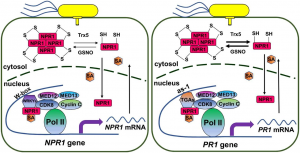 NPR1 (NONEXPRESSER OF PR GENES1) is a master regulator that controls expression of over 2000 genes during plant defense. NPR1 interacts with transcription factors to activate expression of defense genes, but the mechanism is poorly understood. Chen et al. determined that in the presence of salicylic acid NPR1 recruits both CDK8 (CYCLIN-DEPENDENT KINASE8) and WRKY18 (WRKY DNA-BINDING PROTEIN18) to the NPR1 promoter to upregulate its own expression. CDK8 further interacts with WRKY6, WRKY18, and TGA transcription to recruit RNA polymerase II and initiate transcription. NPR1 also binds to other defense gene promoters to recruit its associated transcription factors and therefore RNA polymerase II. CDK8 and its associated Mediator subunits were identified to have a previously undescribed role as positive regulators of immunity for gene expression and systemic acquired resistance. Overall, these results showcase positive regulation by NPR1 on its own promoter and provide more details about the mechanisms of gene activation during plant immunity. (Summary by Katy Dunning @plantmomkaty) Plant Physiol. 10.1104/pp.19.00124
NPR1 (NONEXPRESSER OF PR GENES1) is a master regulator that controls expression of over 2000 genes during plant defense. NPR1 interacts with transcription factors to activate expression of defense genes, but the mechanism is poorly understood. Chen et al. determined that in the presence of salicylic acid NPR1 recruits both CDK8 (CYCLIN-DEPENDENT KINASE8) and WRKY18 (WRKY DNA-BINDING PROTEIN18) to the NPR1 promoter to upregulate its own expression. CDK8 further interacts with WRKY6, WRKY18, and TGA transcription to recruit RNA polymerase II and initiate transcription. NPR1 also binds to other defense gene promoters to recruit its associated transcription factors and therefore RNA polymerase II. CDK8 and its associated Mediator subunits were identified to have a previously undescribed role as positive regulators of immunity for gene expression and systemic acquired resistance. Overall, these results showcase positive regulation by NPR1 on its own promoter and provide more details about the mechanisms of gene activation during plant immunity. (Summary by Katy Dunning @plantmomkaty) Plant Physiol. 10.1104/pp.19.00124
The negative effect of a vertically transmitted fungal endophyte on seed longevity is stronger than that of ozone transgenerational effect ($)
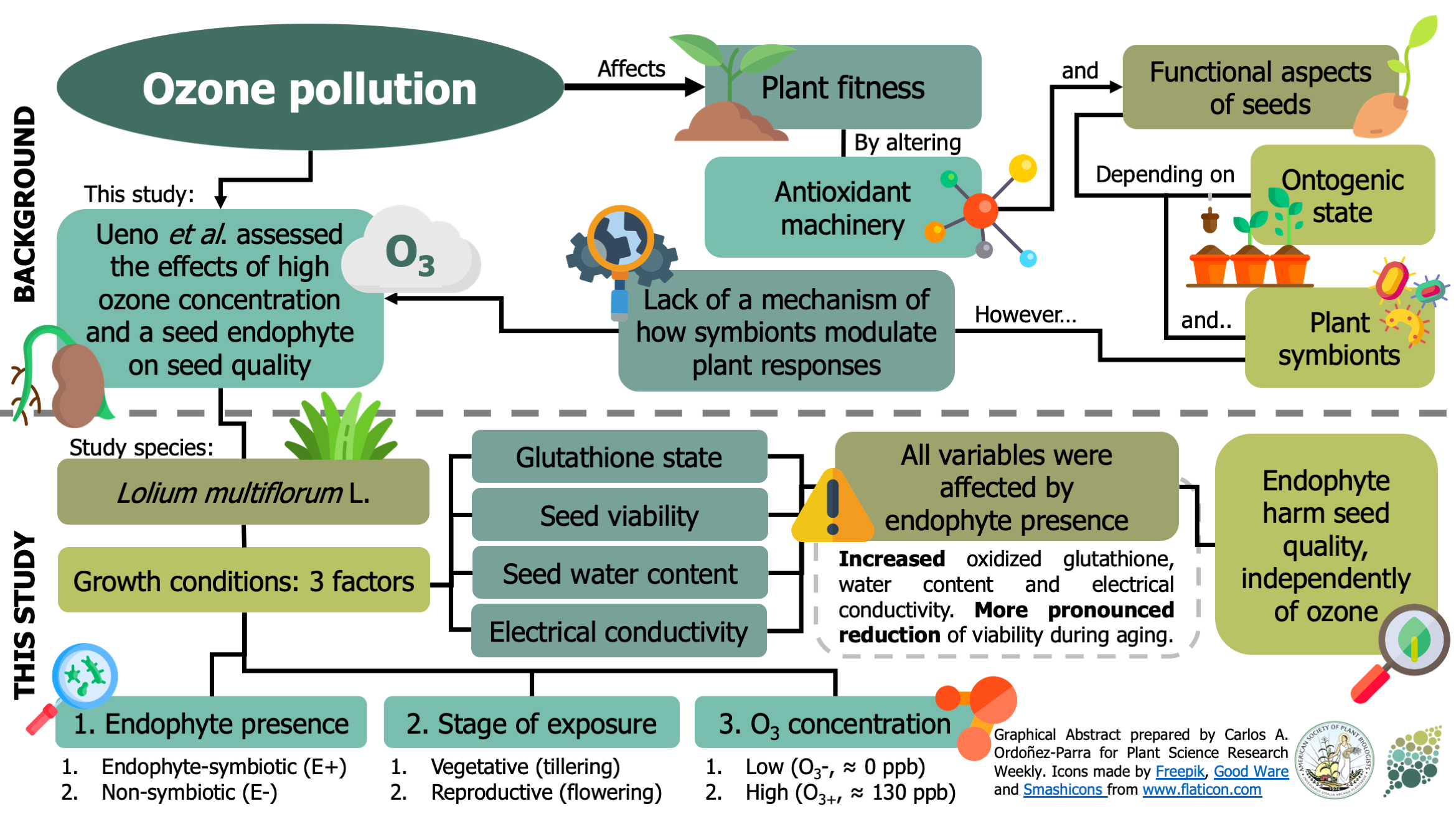 Global environmental change brings new challenges to plants at different levels, including seed development and persistence. For example, the increasing ground-levels of ozone (O3) can affect seed viability, as a result of changes in the mother plant antioxidant machinery. These responses might depend on the ontogenic state of the plants and the interaction with symbiont organisms. In Poöideae grasses, the Epichloë fungal endophytes are transmitted between mother plants and developing seeds, negatively affecting the longevity of the latter. However, the mechanism behind this effect is still missing. Here, Ueno et al. analyzed the effects of ozone and E. occultans on the seed physiology of Lolium multiflorum. To achieve this, the authors harvested the seeds of plants grown both free and associated with E. occultans and exposed to high O3 concentrations in either their tillering or flowering phase. They found that neither the O3 treatment nor the exposure stage affected seed quality significantly. However, the presence of E. occultans hampered the longevity L. multiflorum seeds by altering their oxidative state and increasing their water contents. As a result, the authors conclude that –even if O3 does not directly affect seeds– E. occultans will lead plants to produce seeds more susceptible to O3 pollution and potentially less persistent in the soil. (Summary by Carlos A. Ordóñez-Parra @caordonezparra) Environ. Exp. Bot. 10.1016/j.envexpbot.2020.104037
Global environmental change brings new challenges to plants at different levels, including seed development and persistence. For example, the increasing ground-levels of ozone (O3) can affect seed viability, as a result of changes in the mother plant antioxidant machinery. These responses might depend on the ontogenic state of the plants and the interaction with symbiont organisms. In Poöideae grasses, the Epichloë fungal endophytes are transmitted between mother plants and developing seeds, negatively affecting the longevity of the latter. However, the mechanism behind this effect is still missing. Here, Ueno et al. analyzed the effects of ozone and E. occultans on the seed physiology of Lolium multiflorum. To achieve this, the authors harvested the seeds of plants grown both free and associated with E. occultans and exposed to high O3 concentrations in either their tillering or flowering phase. They found that neither the O3 treatment nor the exposure stage affected seed quality significantly. However, the presence of E. occultans hampered the longevity L. multiflorum seeds by altering their oxidative state and increasing their water contents. As a result, the authors conclude that –even if O3 does not directly affect seeds– E. occultans will lead plants to produce seeds more susceptible to O3 pollution and potentially less persistent in the soil. (Summary by Carlos A. Ordóñez-Parra @caordonezparra) Environ. Exp. Bot. 10.1016/j.envexpbot.2020.104037


